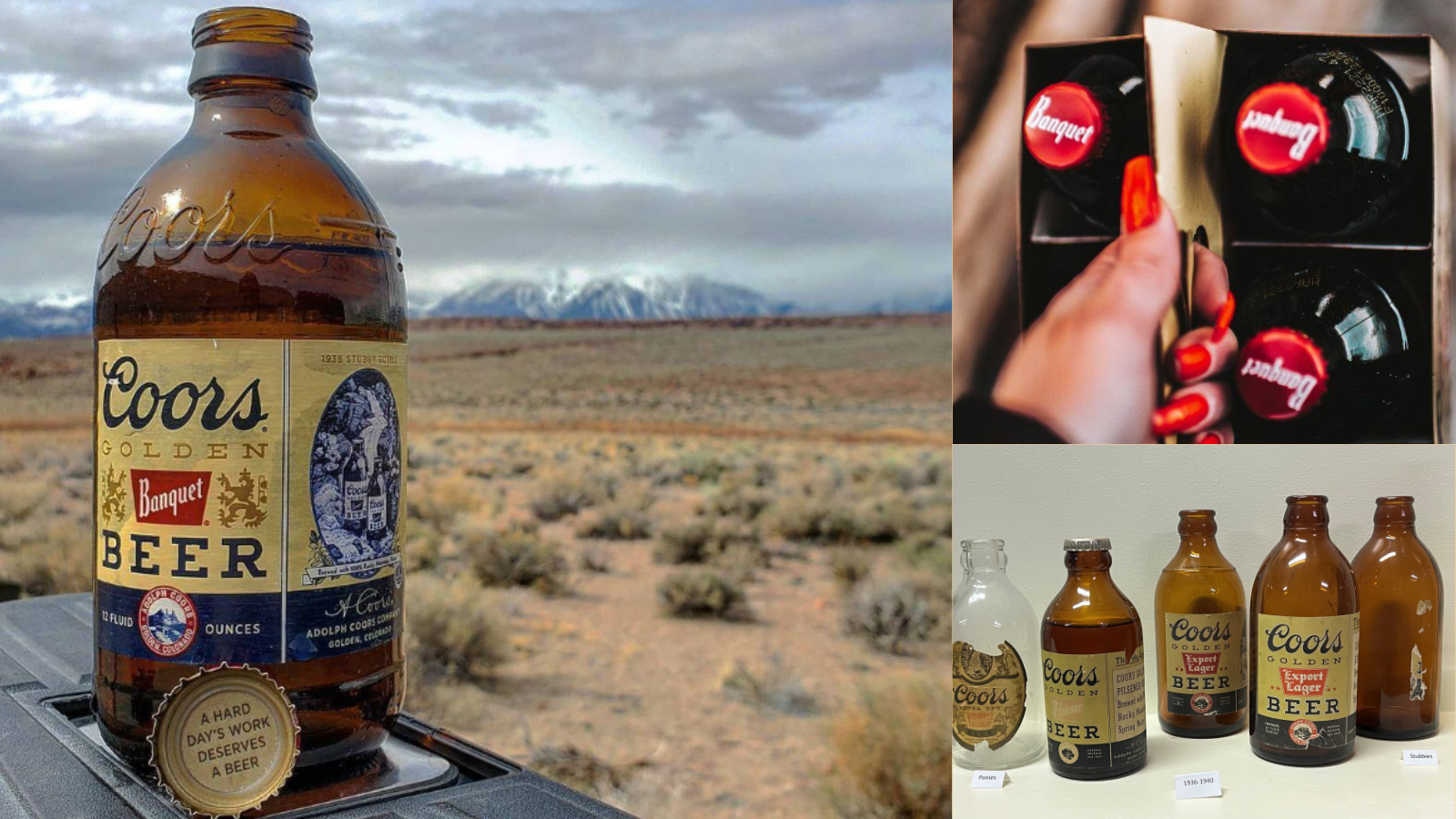As Coors Banquet leads the celebration of Coors’ 150th anniversary this year, 2023 marks another milestone: It’s been 10 years since Coors Banquet’s iconic stubby bottles returned to the market.
The distinct bottles with the pale yellow label tell part of the story, inscribed with “1936 stubby bottle” above an artist’s rendering of a Colorado creek.
First introduced in 1936, shortly after Prohibition ended, the 12-ounce bottles were foreign to consumers, who were used to seeing Banquet in an array of bottles, including 5-, 8- and 11-ounces, as well as 12-ounce cans, says Coors’ archivist Heidi Harris.
Heidi Harris: “Consumers weren’t too particularly happy with the stubby bottle, because they thought they were getting shorted on the amount of beer. Since it was shorter, they thought they were getting less beer, when in reality, it was 12 ounces. Some labels even said, ‘same as tall bottle.’”
Coors had good reasons for changing the packaging: with the stubby bottle, more product could fit onto trucks destined for Banquet’s 11-state distribution area. But the concept didn’t fly with consumers, Harris says. Coors let them have their say, providing comment cards drinkers could send back to the brewery.
Harris: “It’s interesting that, back in the ‘30s, they were bothering asking consumers. I think it shows they cared and wanted to do right by consumers. After a while, they realized consumers’ appreciation for the stubby bottle wasn’t there.”
Within four years, Coors Banquet returned to longnecks and continued to be sold in cans. Fast forward a few decades to the mid-2000s, and the brand was on a roll, finding growth in the off-premise. But on-premise sales told a different story, says Adrian Benkonvich, who managed the Coors Banquet brand at the time and is now president of Hop Valley Brewing.
Adrian Benkonvich, former Coors Banquet brand manager: “A lot of the growth was rooted in the brand’s authenticity. All facets of the brand were growing, except in the on-premise. Simply put, we were trying to find a solution to the on-premise problem.”
A new draft handle didn’t help, as Banquet competed with fast-turning domestic lights and an onslaught of insurgent craft brands.
Benkonvich: “We decided our way to solve this problem was to find a way in with packaging. The cans were doing well in the off-premise, and we wondered, ‘How do we do that in the on-premise environment?’”
Banquet had seen success with its heritage packaging, which paid tribute to historic iterations of the cans.
David Coors, former Coors Banquet associate brand manager: With that brand, it’s all about authenticity. How do you elevate the authenticity of the brand and drive differentiation? That was one of the key drivers, giving people a piece of history they can hold in their hand.
Benkonvich and Coors, now Molson Coors’ vice president of spirits, decamped to the company’s archives, located in a spartan warehouse-like space within the Golden brewery complex. There, they found a collection of old bottles, which provided inspiration for how to turn the brand’s off-premise performance around.
Coors: “We were thumbing through archive materials and one of those was an old pamphlet that had packaging and an image of all the bottles across the decades. We kicked around the idea of doing a limited-time offering packaging with bottles. We put three into testing.
“The stubby bottle won in consumer research. Then it kicked off into a project team. I remember one of the challenges was they didn’t want to do the embossing on the shoulder of the bottle. We were hellbent: If we don’t have that embossing, we’re not doing it. I’m glad we stuck with it.”
Benkonvich: “It’s rooted in authenticity and history. It was launched to help make ends meet. We thought, we have a story, it’s authentic and disruptive and different.”
Harris: “They had something different, something that would make the stubby stand out and pull it back to the old Banquet days.”
Benkonvich: “Our instructions were don’t make Pete Coors mad.”
The stubby bottle officially launched in June 2013. The next challenge was getting distributors to buy in to the change. Would 21st century consumers be as wary as those fickle drinkers in the ‘30s? Would it be confused with Red Stripe, which used a similar short bottle?
Coors: “Any time there’s change, people are a little nervous, especially at the time when the brand was healthy. Anything can work in testing, but you never know before you put it in front of consumers.”
Eventually, with a differentiated product that wasn’t fighting the draft array, distributors came around. And consumers had something cool that stood out when they sipped on Banquet at the bar.
Coors: “Giving people a piece of history they can hold in their hand is a cool way to drive what the brand is all about.”
For both Benkonvich and Coors, getting the stubby bottle into market is a high point of their careers.
Benkonvich: “To me, I see it on a shelf, I see someone talking about, it’s a very significant point of pride. It’s an idea two people manifested and said this is what we’re going to do.”
 Coors: “Anytime in your career in marketing, you’re going to have moments you’re proud of and this is definitely one of those. You have to take risks and sometimes things work. It’s nice that’s one of them that did.”
Coors: “Anytime in your career in marketing, you’re going to have moments you’re proud of and this is definitely one of those. You have to take risks and sometimes things work. It’s nice that’s one of them that did.”
This summer, the Banquet stubby is undergoing another (temporary) change. Its famous yellow label says, “Coors Banquet: 150 years strong.”


